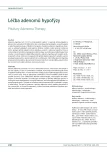Limbic Encephalitis – Two Case Reports
Authors:
V. Majerová 1; J. Roth 1; J. Waishaupt 2; O. Bezdíček 1; M. Miler 1; E. Růžička 1; A. Mitášová 3; J. Bednařík 3,4; R. Jura 3; P. Balabánová 3; R. Rusina 5
Authors‘ workplace:
Neurologická klinika a Centrum klinických neurověd 1. LF UK a VFN v Praze
1; Neurologické odd., Oblastní nemocnice Jičín, a. s.
2; Neurologická klinika LF MU a FN Brno
3; Středoevropský technologický institut (CEITEC), MU, Brno
4; Neurologická klinika IPVZ a FTNsP, Praha
5
Published in:
Cesk Slov Neurol N 2011; 74/107(3): 335-338
Category:
Case Report
Overview
Limbic encephalitis was initially described as a rare paraneoplastic syndrome characterized by rapid progression, anterograde amnesia, mood disturbances, psychiatric symptoms and temporal lobe epilepsy. In the last decade, the concept of limbic encephalitis has expanded – apart from any paraneoplastic aetiology, it may occur as an infectious or autoimmune disorder (that may or may not be associated with antineuronal antibodies). Due to its various non-specific symptoms, early diagnosis of limbic encephalitis is frequently difficult. The first reported case, a 53-year-old female, presented with short-term memory loss, and was treated initially for Alzheimer’s disease, later developing typical symptoms of limbic encephalitis with rapid alteration of consciousness, accompanied by seizures and discrete temporal lobe signal change on MRI. The second case was a 38-year-old male with rapidly progressing amnesia and behavioural disturbances. Development of epileptic seizures, typical medial temporal lobe signal change on MRI and abnormal increase of antibodies against voltage-gated potassium channels confirmed a diagnosis of limbic encephalitis. Both cases improved after corticosteroid therapy. No paraneoplastic origin was found in either case. We discuss the most usual signs and symptoms of limbic encephalitis, focusing on recent classification, diagnostics and treatment of this often under-diagnosed disorder.
Key words:
limbic encephalitis – paraneoplastic syndrome – antineuronal antibodies
Sources
1. Anderson NE, Barber PA. Limbic encephalitis – a review. J Clin Neurosci 2008; 15(9): 961–971.
2. Gultekin SH, Rosenfeld MR, Voltz R, Eichen J, Posner JB, Dalmau J. Paraneoplastic limbic encephalitis: neurological symptoms, immunological findings and tumour association in 50 patients. Brain 2000; 123(7): 1481–1494.
3. Schott JM. Limbic encephalitis: a clinician‘s guide. Practical Neurology 2006; 6(3): 143–153.
4. Cartalat-Carel S, Leston N, Ducray F, Rogemond V, Honnorat J. Limbic encephalitis. A misdiagnosed syndrome. Psychol Neuropsychiatr Vieil 2008; 6(3): 209–218.
5. Lawn ND, Westmoreland BF, Kiely MJ, Lennon VA, Vernino S. Clinical, magnetic resonance imaging, and electroencephalographic findings in paraneoplastic limbic encephalitis. Mayo Clin Proc 2003; 78(11): 1363–1368.
6. Scheid R, Lincke T, Voltz R, von Cramon DY, Sabri O. Serial 18F-fluoro-2-deoxy-D-glucose positron emission tomography and magnetic resonance imaging of paraneoplastic limbic encephalitis. Arch Neurol 2004; 61(11): 1785–1789.
7. Graus F, Saiz A. Limbic encephalitis: a probably under-recognized syndrome. Neurologia 2005; 20(1): 24–30.
8. Tuzun E, Dalmau J. Limbic encephalitis and variants: classification, diagnosis and treatment. Neurologist 2007; 13(5): 261–271.
9. Vedeler CA, Storstein A. Autoimmune limbic encephalitis. Acta Neurol Scand 2009; 120 (Suppl 189): 63–67.
10. Tyler KL. Update on herpes simplex encephalitis. Rev Neurol Dis 2004; 1(4): 169–178.
11. Steiner I, Budka H, Chaudhuri A, Koskiniemi M, Sainio K, Salonen O et al. Viral meningoencephalitis: a review of diagnostic methods and guidelines for management. Eur J Neurol 2010; 17(8): 999–1009.
12. Bataller L, Kleopa KA, Wu GF, Rossi JE, Rosenfeld MR, Dalmau J. Autoimmune limbic encephalitis in 39 patients: immunophenotypes and outcomes. J Neurol Neurosurg Psychiatry 2007; 78(4): 381–385.
13. Shams‘ili S, de Beukelaar J, Gratama JW, Hooijkaas H, van den Bent M, van‘ t Veer M et al. An uncontrolled trial of rituximab for antibody associated paraneoplastic neurological syndromes. J Neurol 2006; 253(1): 16–20.
14. Bataller L, Dalmau JO. Paraneoplastic disorders of the central nervous system: update on diagnostic criteria and treatment. Semin Neurol 2004; 24(4): 461–471.
Labels
Paediatric neurology Neurosurgery NeurologyArticle was published in
Czech and Slovak Neurology and Neurosurgery

2011 Issue 3
- Memantine Eases Daily Life for Patients and Caregivers
- Memantine in Dementia Therapy – Current Findings and Possible Future Applications
- Metamizole at a Glance and in Practice – Effective Non-Opioid Analgesic for All Ages
- Advances in the Treatment of Myasthenia Gravis on the Horizon
Most read in this issue
- Pituitary Adenoma Therapy
- Limbic Encephalitis – Two Case Reports
- A patient in Persistent Vegetative State and his Rehabilitation
- Mild Brain Injury – Intracranial Complications and Indication Criteria for CT Imaging
